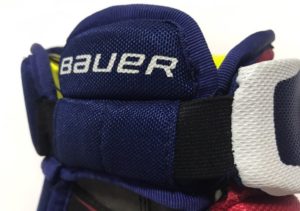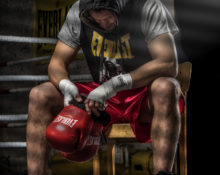Hockey gloves (hags) are an element of a hockey player’s equipment. Protects fingers, knuckles and bones of the hand, as well as the lower part of the forearms from damage caused by blows with a stick, falls on the ice, collisions with other players and fences. Despite the carefully designed protection system, it does not reduce the mobility and flexibility of the upper limbs. The more correctly the gloves are selected in terms of design and size, the higher the functionality.
Design elements of gaiter
Main details:
 protective plates (located on the outside, structurally differ depending on the model);
protective plates (located on the outside, structurally differ depending on the model);- thumb reinforcer (insert that protects against dislocation and impacts);
- protective cuff (responsible for the safety of the wrist joint and lower part of the forearm);
- palmar part.
The grip of the hockey stick and puck depends on the last detail. The wear resistance of this element often determines the service life of the glove itself.
How to determine the right size of hockey gloves?
There are several reference parameters.Most often they rely on:
- for age;
- height;
- body weight;
- the distance between the elbow pad and the tip of the longest finger.
 The first guideline divides products for hockey players into products intended only for children, for juniors and for adults. Children's gloves are aimed at primary school students (6–9 years old). Junior ones are worn by those who are already 8 years old, but not yet 15. All other models are intended for adults with the appropriate hand parameters.
The first guideline divides products for hockey players into products intended only for children, for juniors and for adults. Children's gloves are aimed at primary school students (6–9 years old). Junior ones are worn by those who are already 8 years old, but not yet 15. All other models are intended for adults with the appropriate hand parameters.
The height and weight of an athlete, in turn, do not always help to correctly determine the size of a hag. Reason: The human body is sometimes disproportionate. So, a short man with a dense build may have arms that are longer than the limbs of a taller man.
Important! You should trust not your height and weight, but the distance between the tip of your index finger and the beginning of the elbow pad. Age will reduce the time it takes to search for your parameter in the pivot table.
To find out the distance, resort to a measuring tape. When applying it, make sure that it lies straight, without tilting in one direction or another. After taking measurements, write down the result in centimeters. This length measure is suitable for the size chart used by Russian and some European manufacturers.
size table
To make it easier to find your size, first pay attention to the age range. By age group, it is easy to find the distance connecting the index finger and the edge of the elbow pads.

Tips - how to choose the size
Recommendations and useful notes:
 There is no need to blindly trust the table. The system that underlies it is often used, but not the only one possible. In order not to miss, it is better to use the metric presented on the website of a particular store or information provided by the seller of the outlet.
There is no need to blindly trust the table. The system that underlies it is often used, but not the only one possible. In order not to miss, it is better to use the metric presented on the website of a particular store or information provided by the seller of the outlet.- Due to growth spurts, measurements needed to purchase baby equipment must be taken every 2 months. Suitable will avoid the compressive load on the bones and joints of the teenage athlete.
- When trying on gloves, it makes sense to wear elbow pads.. This way you can understand whether they fit together and whether there is a gap between them.
- Although the gap between the elbow pads and gloves is undesirable, a tight fit of 2 pieces of equipment will not lead to anything good. With such equipment, mobility decreases and movement becomes stiff.
- For a short pair of gloves, you should choose elongated elbow pads.
- When trying on, please pay attention to: do your fingers touch the walls?. With the correct size, this does not happen.
- It is also worth remembering that any natural glove leather, no matter how well it is made, stretches over time. Therefore, never buy a pair larger than you need (this primarily applies to parents trying to save money or athletes who do not like the normal fit of hags).


 protective plates (located on the outside, structurally differ depending on the model);
protective plates (located on the outside, structurally differ depending on the model); There is no need to blindly trust the table. The system that underlies it is often used, but not the only one possible. In order not to miss, it is better to use the metric presented on the website of a particular store or information provided by the seller of the outlet.
There is no need to blindly trust the table. The system that underlies it is often used, but not the only one possible. In order not to miss, it is better to use the metric presented on the website of a particular store or information provided by the seller of the outlet. 0
0





